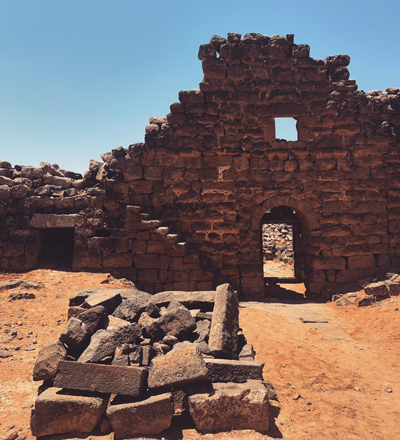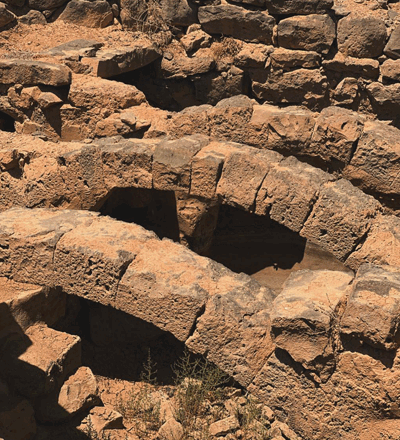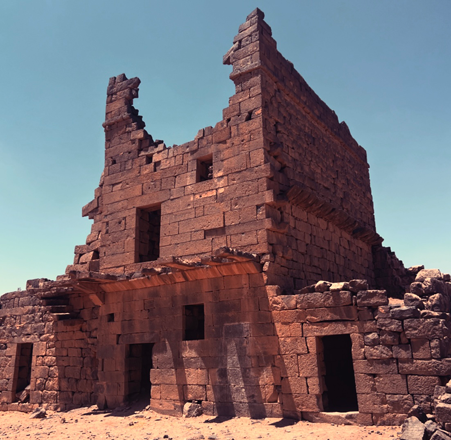You are here
After Umm Al Jimal, work in progress to inscribe other sites on UNESCO World Heritage List – official
By Heba Elayyan - Aug 04,2024 - Last updated at Aug 04,2024

Director General of the Department of Antiquities Fadi Balawi says that Umm Al Jimal has witnessed many civilizations spanning nearly 2,000 years, with influences from the Nabataean, Roman, Byzantine, Umayyad, Mamluk, Ottoman, and modern periods (Photos by Sophie Constantin)
Umm Al Jimal/Mafraq — Following the inscription of Umm Al Jimal on the UNESCO World Heritage List, Jordan is working on registering other sites as universally-protected landmarks, including the Aqaba Marine Reserve.
During a tour to the Umm Al Jimal historic site, some 90 kilometres northeast of Amman, Director General of the Department of Antiquities (DoA) Fadi Balawi said that Jordan is allowed to submit one file each year to add a site to the World Heritage List, with the evaluation process taking two years. “Although we have many sites to present, we must adhere to the stipulated timeframe."
The tour on Saturday was organised after the declaration of the Umm Al Jimal as a World Heritage site during the 46th session of the World Heritage Committee Meeting in July in New Delhi. The tour was co-organised by the Ministries of Tourism and Antiquities, Government Communication, and Investment under the “Tafaseel” (Details) programme.
Umm Al Jimal has been added to the list under the third criterion of UNESCO's ten selection standards, Balawi said in an interview with The Jordan Times.
The tour aimed to highlight the future plans of the Ministry of Tourism and Antiquities and the Ministry of Investment to promote the site, as well as to present Umm Al Jimal, which is the seventh Jordanian site to be added to UNESCO’s World Heritage List, along with Petra, QuseirAmra, Umm Al-Rasas, Wadi Rum, Mughatas (Baptism site) and Salt.
According to UNESCO, the third criterion requires a site to "bear a unique or at least exceptional testimony to a cultural tradition or to a civilization which is living or which has disappeared."
Balawi said that Umm Al Jimal met the third standard due to its well-preserved ruins that demonstrate the presence of past civilizations and their unique architectural contributions.
“Umm Al Jimal has witnessed many civilizations spanning nearly 2,000 years, with influences from the Nabataean, Roman, Byzantine, Umayyad, Mamluk, Ottoman, and modern periods,” Balawi said.
"We can see the influence of various civilizations in Umm Al Jimal through the architecture of its 150 houses, 16 churches, three mosques, and a cathedral and Umayyad mosque."
Balawi said that the site is also notable for its advanced water system, featuring dams, over ten water reservoirs, and 28 water ponds, all interconnected.
On the process of registering Umm Al Jimal, Balawi explained, “First, we prepare a preliminary file to gather all information about the site and conduct thorough studies. The most challenging part is developing a comprehensive management plan, a requirement for World Heritage List registration."
"Despite the complexities, the registration of Umm Al Jimal was completed in three years, a relatively short period compared with other sites that can take up to 15 years due to the lack of a scientific approach."
“Recording Umm Al Jimal is a partnership between the local community, various partners, and the Department of Antiquities. We achieved this without altering the original file, which is a significant accomplishment for Jordan."
In addition to Umm Al Jimal, he said that Jordan is working on registering other sites. “Currently, we are in the process of recording Aqaba Marine Reserve to preserve the coral reef."
Minister of Tourism and Antiquities Makaram Qaisi said that the recognition of Umm Al Jimal by UNESCO highlights Jordan's rich cultural heritage, with more than 100,000 archaeological sites, and the ongoing efforts to preserve and celebrate its historical landmarks.
The media tour included 11 sites in Umm Al Jimal, including churches, water engineering infrastructure, a range of Roman military and residential structures and an Umayyad mosque.
Media representatives also visited the local women's handicraft production exhibition to view the association’s products.

Related Articles
AMMAN — The United Nations Educational, Scientific and Cultural Organisation (UNESCO) has announced the inclusion of Umm Jimal to the UNESCO
AMMAN — The Tourism Ministry, represented by the Department of Antiquities, referred to UNESCO a nomination file for the archaeological site
AMMAN — The recent inclusion of the Umm Al Jimal archaeological site on UNESCO’s World Heritage List, highlights its exceptional universal v













